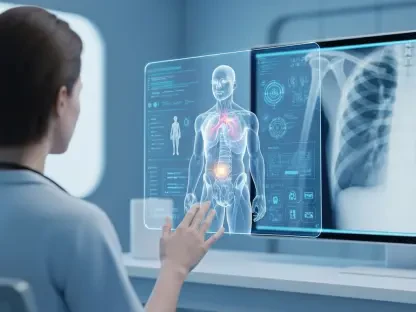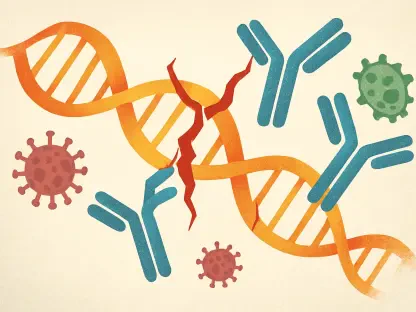In the intricate world of scientific research, laboratory work often involves a relentless cycle of repetitive tasks that can sap both time and energy from researchers who are eager to dive into the more innovative and analytical facets of their projects, slowing down the pace of discovery. Tasks like sample preparation, pipetting, and running cell assays, while essential, frequently act as bottlenecks, diverting focus from critical thinking. Fortunately, a transformative shift is emerging with the advent of accessible automation, a technological advancement poised to redefine how labs function. This development promises not only to streamline mundane processes but also to democratize access to cutting-edge tools, ensuring that researchers across various fields and budget constraints can benefit. By tackling long-standing barriers and introducing user-friendly solutions, accessible automation stands ready to enhance efficiency and foster innovation. This article delves into the challenges of traditional automation, explores a pioneering new system, and considers the broader implications for the future of lab work.
Overcoming Traditional Automation Challenges
The journey to integrate automation into laboratory settings has historically been fraught with obstacles that have limited its reach to only the most well-resourced institutions. Conventional systems, such as advanced liquid handling platforms, often come with prohibitively high price tags that exclude smaller labs or those operating on tight budgets. Beyond cost, these systems typically demand extensive training and specialized skills, sometimes requiring researchers to master complex coding or proprietary software. This steep learning curve creates a significant entry barrier, leaving many scientists reliant on manual methods despite the potential for efficiency gains. Moreover, there’s a pervasive concern among lab professionals about automation leading to job redundancy, a fear that further dampens enthusiasm for adopting such technologies. These combined challenges have long confined automation to niche, high-budget environments, underscoring the need for more inclusive solutions that can bridge the gap for a wider range of researchers.
Another critical aspect of traditional automation hurdles lies in the rigidity and lack of adaptability inherent in many existing systems. Often, labs must conform their workflows to the specifications of the automation tools, rather than the tools adapting to the unique needs of the lab. This inflexibility can disrupt established processes and force researchers to overhaul protocols, adding another layer of complexity to an already daunting transition. Additionally, the maintenance and troubleshooting of these systems frequently require external technical support, further driving up costs and dependency. For many in the scientific community, these factors compound the hesitation to embrace automation, as the perceived risks and disruptions outweigh the potential benefits. Addressing these systemic issues is essential to making automation a viable option for diverse lab environments, paving the way for innovations that prioritize accessibility and user empowerment over exclusivity.
Introducing a Game-Changing Solution
A significant leap forward in addressing these longstanding issues comes with Merck’s Automated Assay Workstation (AAW™), powered by Opentrons®, a system designed to break down the barriers that have historically plagued lab automation. Unlike its predecessors, the AAW™ is crafted with affordability and modularity at its core, ensuring that labs of varying sizes and financial capacities can adopt this technology without overextending resources. Its DIY-friendly nature allows researchers to customize the system to suit specific experimental needs, offering a stark contrast to the rigid frameworks of traditional platforms. This adaptability means that whether a lab is just starting to explore automation or looking to enhance existing setups, the AAW™ can be tailored accordingly. By prioritizing ease of integration, this workstation is set to make automation a realistic and practical choice for a much broader spectrum of scientific endeavors.
Equally impressive is how the AAW™ workstation redefines the user experience by eliminating the need for extensive technical expertise. Researchers are no longer required to possess advanced coding skills or undergo lengthy training to operate the system effectively. Instead, the platform is designed to be intuitive, enabling both novices and seasoned automation users to navigate its features with minimal friction. The system’s modular design also supports incremental upgrades, allowing labs to start with basic functionalities and scale up as needs evolve or budgets allow. This approach not only reduces the upfront financial burden but also builds confidence among users who might otherwise shy away from automation due to complexity or cost concerns. By focusing on user empowerment and flexibility, the AAW™ is positioned as a transformative tool that could fundamentally alter how labs approach their daily operations, making automation an inclusive rather than exclusive asset.
Fostering Growth and Skill Development
Beyond its immediate practical benefits, the AAW™ workstation serves as a catalyst for professional growth within the scientific community by embedding opportunities for skill-building directly into its framework. The system offers tools like the no-code Protocol Designer app, which allows users to create and modify protocols without delving into complex programming. For those interested in deeper customization, an open-source Python API is available, providing a platform for researchers to expand their technical capabilities at their own pace. This dual approach ensures that automation is not just a tool for efficiency but also a means of enhancing expertise, aligning with the broader trend of viewing technology as a collaborative partner. By lowering the technical barriers and offering accessible learning pathways, the AAW™ empowers scientists to embrace automation while simultaneously advancing their professional skill sets.
The emphasis on skill development also addresses a critical cultural shift needed in lab environments, where automation is often met with apprehension due to fears of obsolescence. By equipping researchers with the tools to engage with and understand automation technologies, the AAW™ helps dispel myths about job replacement, instead highlighting how such systems can augment human capabilities. This educational aspect fosters a sense of ownership and control over automated processes, encouraging scientists to see these tools as extensions of their expertise rather than threats. Furthermore, the skills acquired through interacting with the workstation—whether through no-code interfaces or API programming—can be applied beyond immediate lab tasks, contributing to long-term career growth. This focus on upskilling reflects a forward-thinking approach, ensuring that automation serves as a bridge to innovation rather than a barrier, ultimately enriching the scientific community as a whole.
Enhancing Reliability and Productivity
One of the most compelling advantages of the AAW™ system lies in its ability to enhance the reliability of experimental outcomes through the integration of the Millipore® Protocol Library. This expanding repository of verified, automated protocols ensures that researchers can achieve consistent and reproducible results, a cornerstone of credible scientific work. By minimizing human error in repetitive tasks, the library reduces the likelihood of costly experimental re-runs and builds trust in automated processes. Compatibility with existing kits and reagents further eases the transition, as labs can maintain continuity with their current materials while benefiting from automation. This focus on consistency not only saves time but also strengthens the integrity of research data, addressing a fundamental need in labs where precision is paramount and variability can undermine years of effort.
In tandem with improved reliability, the AAW™ workstation significantly boosts lab productivity by automating time-intensive tasks, thereby freeing researchers to focus on higher-value activities like data analysis and hypothesis development. The ability to handle larger workloads with reduced hands-on time translates to faster research timelines, a critical advantage in competitive scientific fields where speed can determine breakthroughs. This increase in throughput does not come at the expense of quality, as the system’s design ensures that automated tasks are executed with precision. Labs adopting this technology can expect to see a marked improvement in operational efficiency, allowing for more experiments to be conducted within the same timeframe. This productivity gain is a testament to how accessible automation can reshape day-to-day lab dynamics, enabling scientists to channel their efforts into innovation rather than routine, thus accelerating the pace of discovery across diverse disciplines.
Envisioning a New Standard for Laboratories
The implications of accessible automation extend far beyond individual labs, hinting at a future where advanced tools become a standard across the scientific landscape, regardless of budget or scale. Systems like the AAW™ are paving the way for this democratization by aligning seamlessly with existing workflows rather than demanding disruptive overhauls. This compatibility ensures that labs can adopt automation without sacrificing the integrity of their established processes, making the transition smoother and more appealing. As more researchers gain access to such technologies, the collective pace of scientific progress is likely to quicken, with automation serving as a catalyst for discoveries that might otherwise be delayed by manual constraints. The vision of an automated lab environment is no longer a distant dream but an imminent reality, one that promises to level the playing field for all.
Looking ahead, the ripple effects of accessible automation suggest a redefined lab culture where technology and human ingenuity work hand in hand to push boundaries. The adaptability of platforms like the AAW™ ensures that labs can evolve alongside emerging research needs without being tethered to outdated or inflexible systems. This forward-looking approach also opens doors for smaller or underfunded labs to contribute to global scientific advancements, fostering a more inclusive research ecosystem. By reducing dependency on specialized expertise and high-cost infrastructure, accessible automation stands to empower a new generation of scientists to tackle complex challenges with confidence. As this trend gains momentum, it’s clear that the integration of user-friendly, modular automation tools will play a pivotal role in shaping the laboratories of tomorrow, setting a new benchmark for efficiency, equity, and innovation in scientific exploration.









